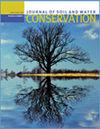结合跃变冲击传感器和风洞研究风蚀过程——以新疆准东矿区为例
IF 2.6
4区 农林科学
Q2 ECOLOGY
引用次数: 0
摘要
表层土壤的性质决定了土壤的可蚀性,风力决定了土壤的侵蚀强度,两者决定了土壤的侵蚀量。在中国新疆准东矿区,近10年来连续的采矿和建设活动,导致降水形成的表层地壳被破坏,土壤逐渐细化,可蚀性增加。为了准确描述人类建设对当地风蚀的影响,我们在风洞中安装了跃变冲击传感器,探索土壤对风蚀的响应以及人为干扰对风蚀速率的影响。我们人为地控制土壤湿度、结皮覆盖率和颗粒大小,并使土壤受到不同风速的影响。结果表明:①在土壤结皮和水分实验中,传感器可以有效监测风蚀过程和风蚀量,但在土壤粒径整体发生变化后,传感器的监测效率大大降低;第二,三个试验组的风蚀过程大致相同:在最初的0 ~ 30秒内,风开始驱动土壤颗粒运动。在30 ~ 240 s风速范围内,随着风速的增大,土壤颗粒释放量迅速增加,在240 ~ 480 s风速范围内趋于稳定后,土壤颗粒释放量逐渐减少,在480 s风速范围内保持稳定。第三,地壳的均匀分布比地壳的集中分布可以减少20%的土壤侵蚀。结壳的存在可以有效地防止风蚀早期的侵蚀,土壤表面结壳越完整,抵抗持续风蚀的能力越强。第四,土壤中的水分通过增加早期移动颗粒所需的风速,有效地阻碍了侵蚀;但持续侵蚀使土壤水分降低,后期侵蚀土壤比例逐渐增大。(5)侵蚀速率数据表明,粒径变化可导致最大的风蚀速率为2599 g m-2 min-1,是影响风蚀的最主要因素。本文章由计算机程序翻译,如有差异,请以英文原文为准。
Combining a saltation impact sensor and a wind tunnel to explore wind erosion processes—A case study in the Zhundong mining area, Xinjiang, China
The properties of surface soil determine its erodibility, the wind force determines the soil erosion intensity, and both factors determine the amount of soil erosion. In the Zhundong mining area in Xinjiang, China, continuous mining and construction activities in the past 10 years have resulted in the destruction of surface crust formed by precipitation, the gradual refinement of soil, and an increase in erodibility. To accurately describe the impact of human construction on local wind erosion, we installed a saltation impact sensor in a wind tunnel to explore the soil responses to wind erosion and changes in the wind erosion rate caused by anthropogenic interference. We artificially manipulated the soil moisture, crust coverage, and particle size, and subjected the soils to different wind speeds. The results show that, first, in soil crust and moisture experiments, a sensor can effectively monitor the process and amount of wind erosion, but the monitoring efficiency of the sensor is greatly reduced after an overall change in soil particle size. Second, the wind erosion processes in the three test groups are roughly the same: the wind starts to drive the soil particles to move for the first 0 to 30 s. Then, the number of released soil particles increases rapidly with increasing wind speed from 30 to 240 s, gradually decreases after the wind speed stabilizes from 240 to 480 s, and then remains consistent after 480 s. Third, a uniform distribution of the crust rather than a concentrated distribution of the crust can reduce soil erosion by 20%. The presence of a crust can effectively prevent erosion in the early stage of wind erosion, and the more complete the surface crust on the soil, the better it can resist continuous wind erosion. Fourth, moisture in the soil effectively impedes erosion by increasing the wind speed required to move particles in the early stage; however, continuous erosion decreases the soil moisture, and the proportion of eroded soil gradually increases in the later stage. Fifth, the erosion rate data show that particle size change can result in a maximum wind erosion rate of 2,599 g m–2 min–1 and is the most influential factor for wind erosion.
求助全文
通过发布文献求助,成功后即可免费获取论文全文。
去求助
来源期刊
CiteScore
4.10
自引率
2.60%
发文量
0
审稿时长
3.3 months
期刊介绍:
The Journal of Soil and Water Conservation (JSWC) is a multidisciplinary journal of natural resource conservation research, practice, policy, and perspectives. The journal has two sections: the A Section containing various departments and features, and the Research Section containing peer-reviewed research papers.

 求助内容:
求助内容: 应助结果提醒方式:
应助结果提醒方式:


